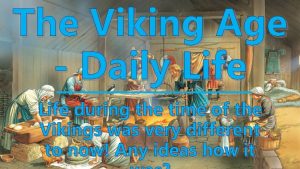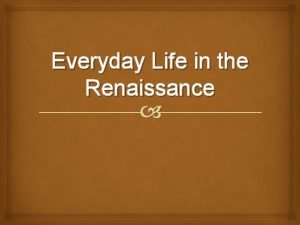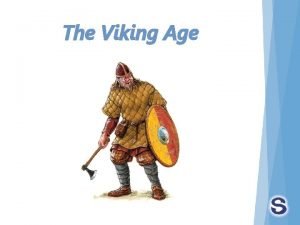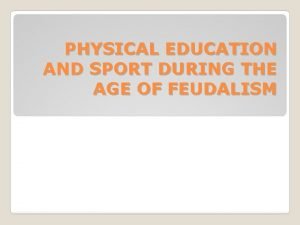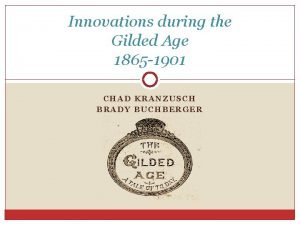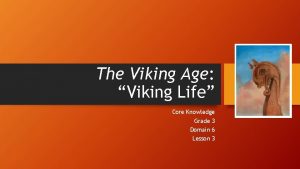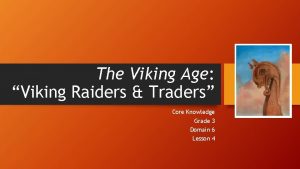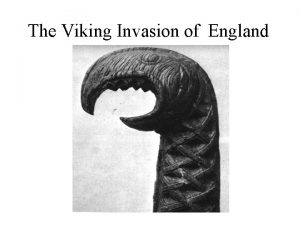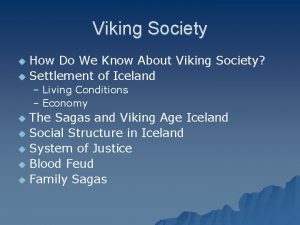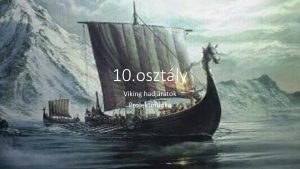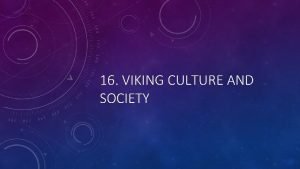The Viking Age Daily Life during the time









- Slides: 9

The Viking Age - Daily Life during the time of the Vikings was very different to now! Any ideas how it

What was the Viking Age? • The Viking Age is from 700 AD to 1100 AD. • This was the time when the Vikings left Scandinavia for Europe. • Travelled to countries such as Britain & Ireland. • Some went to fight & steal treasure. • Others went to settle in new lands as farmers, craftsmen or traders. • They first landed in England in 787 AD, in the raid of Lindisfarne. • They settled & brought lots to Britain. • They even had a English King at one time.

Life in the Viking Age: • Life in the Viking Age was very different to today in many ways. • Today we are going to look at how certain things were different The Viking Age was very including: different to how you live today! ü Food; You are all going to be historians today. This means you ü Clothes; will be looking at how life in the ü Men & Women; Viking Age compares to your life. ü Children’s lives; ü Toys & Pastimes; Is there anything you already know about the Viking Age? ü Slaves.

Viking Food: • Vikings ate what they could grow or hunt. • A lot of vegetables were grown & eaten by Vikings. • Also Vikings would eat wild nuts & berries, and herbs & leaves such as spinach. • Meat was a large part of the Viking diet. • Wild animals & fish were hunted by Vikings. • Some Vikings had their own “domesticated animals” for food - sheep, goats, chickens. • Vikings also enjoyed honey which they would get from wild bee’s nests. • Beer was drank in the form of mead.

Viking Clothes: • Vikings made all of their own clothes. • Most of their clothes were made from wool, linen & animal skins. • Perfect for keeping them warm in cold weather. • Vikings were skilful weavers. • Women & children would spin the wool into yarn & dye it with plants for colour. • Men wore tunics & trousers. • Women wore a long dress with a pinafore. • Clothes were often fastened with belts & brooches.

Viking Men & Women: • Most Viking men were all-round handymen. • They were boat builders, potters, leather-workers & smiths. • Most Viking men knew how to handle a boat. • Most knew how to fight if needed. • Would fight to protect their family or support their chieftain. • Viking women baked bread & made clothing. • Looked after the children & made family meals. • On the farm they milked cows & made cheese.

Children’s Lives: • Viking babies were given small charms of Thor’s hammer. • To protect them from evil spirits & sickness. • Boy’s usually took their father’s name - Eric son of Karl became Eric Karlsson. • Girl’s took the name of their mother or grandmother. • Children didn’t go to school. • Helped parents at home & learnt Viking history, religion & law through spoken word. • By 15 or 16 they were adults. • Girl’s father often chose their husband.

Toys & Pastimes: • Viking’s enjoyed a variety of different pastimes. • Viking men enjoyed swimming, wrestling & horse racing. • In Winter, people skated on frozen rivers. • The favourite board game was called “hnefatafl” or “King’s Table”. • It was a game similar to chess or draughts. • Most children’s toys were homemade. • Whistles made from leg bones of geese. • Children had wooden dolls, played football & sailed model boats.

Slaves: • Vikings sometimes kept slaves. • Slaves did the hardest & dirtiest jobs. • Some people could be born into slavery. • The child of a slave mother & father was a slave too. • However, if your father or mother were free people the child was free too. • Many slaves were people
 Daily viking life
Daily viking life Harlem renaissance inventions
Harlem renaissance inventions Iron age dates
Iron age dates Iron age bronze age stone age timeline
Iron age bronze age stone age timeline Between what years does the viking age elapse?
Between what years does the viking age elapse? Polynomials in real life
Polynomials in real life Start time, end time and elapsed time
Start time, end time and elapsed time Physical education in age of feudalism
Physical education in age of feudalism Historical development of physical education
Historical development of physical education Light bulb gilded age
Light bulb gilded age
